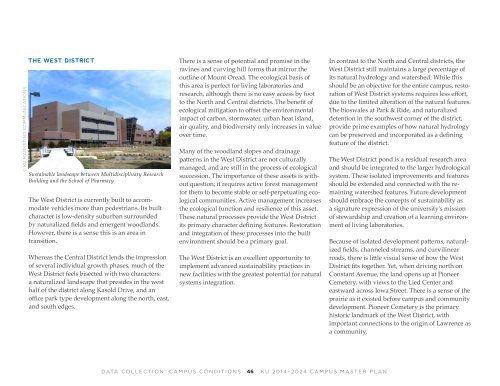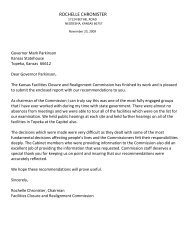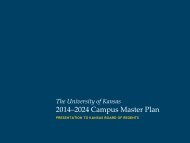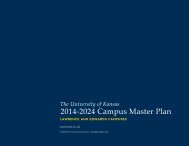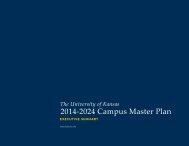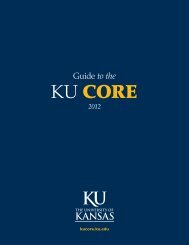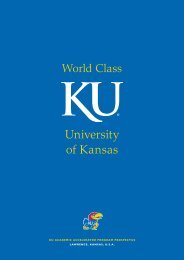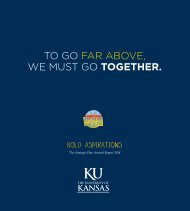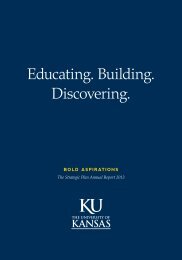KU_Chapter01_DataCollection_2014-06-10
KU_Chapter01_DataCollection_2014-06-10.pdf
KU_Chapter01_DataCollection_2014-06-10.pdf
- No tags were found...
You also want an ePaper? Increase the reach of your titles
YUMPU automatically turns print PDFs into web optimized ePapers that Google loves.
© <strong>KU</strong> MARKETING COMMUNICATIONS<br />
THE WEST DISTRICT<br />
Sustainable landscape between Multidisciplinary Research<br />
Building and the School of Pharmacy<br />
The West District is currently built to accommodate<br />
vehicles more than pedestrians. Its built<br />
character is low-density suburban surrounded<br />
by naturalized fields and emergent woodlands.<br />
However, there is a sense this is an area in<br />
transition.<br />
Whereas the Central District lends the impression<br />
of several individual growth phases, much of the<br />
West District feels bisected with two characters:<br />
a naturalized landscape that presides in the west<br />
half of the district along Kasold Drive, and an<br />
office park type development along the north, east,<br />
and south edges.<br />
There is a sense of potential and promise in the<br />
ravines and curving hill forms that mirror the<br />
outline of Mount Oread. The ecological basis of<br />
this area is perfect for living laboratories and<br />
research, although there is no easy access by foot<br />
to the North and Central districts. The benefit of<br />
ecological mitigation to offset the environmental<br />
impact of carbon, stormwater, urban heat island,<br />
air quality, and biodiversity only increases in value<br />
over time.<br />
Many of the woodland slopes and drainage<br />
patterns in the West District are not culturally<br />
managed, and are still in the process of ecological<br />
succession. The importance of these assets is without<br />
question; it requires active forest management<br />
for them to become stable or self-perpetuating ecological<br />
communities. Active management increases<br />
the ecological function and resilience of this asset.<br />
These natural processes provide the West District<br />
its primary character defining features. Restoration<br />
and integration of these processes into the built<br />
environment should be a primary goal.<br />
The West District is an excellent opportunity to<br />
implement advanced sustainability practices in<br />
new facilities with the greatest potential for natural<br />
systems integration.<br />
In contrast to the North and Central districts, the<br />
West District still maintains a large percentage of<br />
its natural hydrology and watershed. While this<br />
should be an objective for the entire campus, restoration<br />
of West District systems requires less effort,<br />
due to the limited alteration of the natural features.<br />
The bioswales at Park & Ride, and naturalized<br />
detention in the southwest corner of the district,<br />
provide prime examples of how natural hydrology<br />
can be preserved and incorporated as a defining<br />
feature of the district.<br />
The West District pond is a residual research area<br />
and should be integrated to the larger hydrological<br />
system. These isolated improvements and features<br />
should be extended and connected with the remaining<br />
watershed features. Future development<br />
should embrace the concepts of sustainability as<br />
a signature expression of the university’s mission<br />
of stewardship and creation of a learning environment<br />
of living laboratories.<br />
Because of isolated development patterns, naturalized<br />
fields, channeled streams, and curvilinear<br />
roads, there is little visual sense of how the West<br />
District fits together. Yet, when driving north on<br />
Constant Avenue, the land opens up at Pioneer<br />
Cemetery, with views to the Lied Center and<br />
eastward across Iowa Street. There is a sense of the<br />
prairie as it existed before campus and community<br />
development. Pioneer Cemetery is the primary<br />
historic landmark of the West District, with<br />
important connections to the origin of Lawrence as<br />
a community.<br />
DATA COLLECTION: CAMPUS CONDITIONS<br />
46<br />
<strong>KU</strong> <strong>2014</strong>–2024 CAMPUS MASTER PLAN


